- Home
- Injections
- Laser Treatments
- Specialties
Specialtiesview all
- Other Treatments
- Before After Photos
Before After Photosview all
- Contact Us
- Doctor And Staff
- About Celibre
- Blogs
If you’re thinking about getting laser hair removal, we’re excited for you! It’s a great procedure that will literally change your life on a day-to-day basis! Being free from the embarrassment of unwanted hair and the time constraints that go along with constantly getting rid of it is liberating.
Laser hair removal is extremely popular and here at Celibre Medical, we are often asked why we don’t join in the daily barrage of “specials” or “coupons for groups” that so many other med spas and offices promote incessantly. The reason we don’t is that the laser hair removal treatments we provide our patients don’t have any gimmicks and they work. We don’t sell packages force “packages” on patients so when you are new, you can go one treatment at a time. The figure that we charge is based on many factors including three different state-of-the-art lasers, highly skilled, trained and licensed nurses, an excellent safety record, exceptional results (75% – 95% permanent hair removal), and our unparalleled ability to treat any skin type (color). All these figure into how we price our laser hair removal treatments.
We take the time to evaluate and educate our patients up front about the laser hair removal process, in addition to why a certain type of laser technology will work better for them than another and how many total treatments they will need to see full and permanent results. We meticulously maintain our laser equipment and use only devices that have been proven to be effective and are FDA-approved for laser hair removal. We invest in the latest and most up-to-date training for our laser practitioners so that they consistently provide the highest quality treatments that yield impressive results.
For all these reasons, we can’t offer “$29 laser hair removal”. This price is cheaper than waxing so there’s always a catch. We don’t compromise on the quality of patient care or the results we deliver; so, we also don’t compromise on the price of our services. There’s always a trade-off for a lower price, and unfortunately, that is usually poor results. Is that really worth saving a few extra dollars when you’re talking about your skin, your time and your results? You don’t want to have to pay twice for the same service.
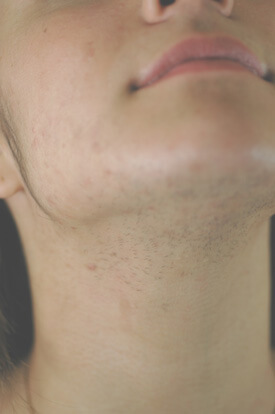
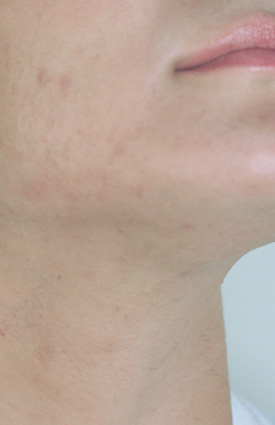
* Laser Hair Removal Before and After Pictures
If you have a tattoo or permanent make-up, you may be surprised to learn that a laser can remove either. In fact, the same type of laser (q-switched lasers) can tackle the job of removing tattoos or permanent makeup.
Even though permanent makeup and tattoos are similar, the removal process is often different. Even though the same laser can be used to remove them, a critical understanding of these two different treatments is necessary if you are going to have successful and safe removal.
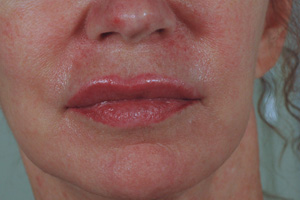
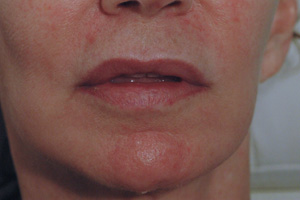
The first difference between tattoos and permanent makeup is the ink that is used. Tattoo ink is much higher quality and heartier than that used in permanent makeup. It might sound backwards, but think of it this way: a tattoo is meant to last your whole life; permanent makeup, on the other hand, can fade significantly through the years. Most permanent makeup artists will tell you that you can expect an average of five years before further work is needed. This is because the ink that’s used is inherently more fragile and a lower quality. For this reason, permanent makeup is generally easier to remove with a laser.
Next, consider the tattooing process. Many layers of ink are deposited into the skin to create a design, picture or word. Permanent makeup may involve a bit of layering, but nothing compared to a tattoo. How does this relate to laser removal? Well, the thicker the ink, the more laser passes (and treatments) it takes to break it up. Again, permanent makeup usually fades faster and with fewer treatments than a tattoo.
The last major difference is the way the two behave during the laser removal treatment process. Because of the nature of the ink that’s used in permanent makeup, it can (and sometimes does) “oxidize” after laser treatment. This makes it turn different colors. Tattoos don’t do this.
This fact can change the number of laser treatments you will need to get rid of your permanent makeup. Usually, it will make the entire process longer. It may also cause you to hide the permanent makeup. Which can change new shades of orange, pale blue or dark grey. While penciling over eyebrows to hide the ink might be a pain in the short term, rest assured the ink will completely fade away with laser treatments no matter what color it turns!
In summary, it’s important that you don’t expect the process of tattoo removal to be the same for your permanent makeup and vice versa. While the differences between the two are subtle, it’s important for your overall success that you understand them fully.
To achieve permanent laser hair removal — where this term represents 75%-95% permanent removal of the hair in 6-8 treatments –– the base of the hair follicle has to be heated to a high enough temperature so that the blood vessels that connect to the base of the hair follicle are disabled. This process involves a temperature high enough to cause some discomfort.
Most patients that have undergone waxing will generally say that <strong”>laser hair removal is more comfortable than waxing. The challenge with describing the discomfort involved with the laser hair removal process is that some patients have a very easy time with laser hair removal and others think it is very painful, and every patient has a different pain tolerance. We can say that since 2004, we have done tens of thousands of laser hair removal treatments and we can count on two hands the number that have opted out of the process because it was too painful.
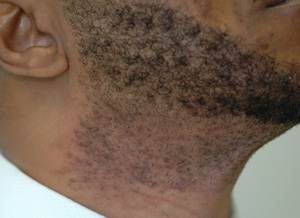
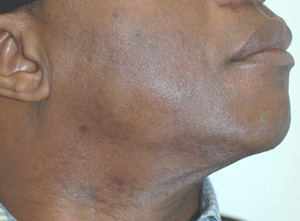
Laser hair removal is most commonly described as feeling like someone is snapping you sharply on the skin with a rubber band. It can also feel like pin pricks or hot sand on the skin.
There are methods to lessen the discomfort level during laser hair reduction including cold gels, numbing creams, and cold air blowers.
Currently, the FDA requires that manufacturers of lasers used for laser hair removal are able to substantiate (via clinical trials) that their product is “Pain Free Laser Hair Removal” or “painless laser hair removal” before they are able to advertise that. There is one manufacturer currently advertising that their laser as pain free, but they have not applied for nor received an FDA approval to substantiate this claim.
This is a question that we hear daily from patients like you. Although you might think we get tired of giving the same answer over and over, we don’t. Our goal is to provide our patients with the most accurate and up-to-date information about the conditions we treat and the procedures we perform. We never tire of helping patients like you choose effective, life-changing treatments that suit their preferences, lifestyles and budgets! All that to say our answer is yes; however, there are a few factors that must be considered:
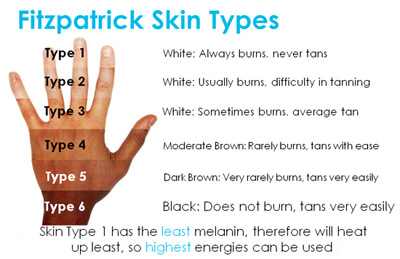
We’re not just talking about credentials here. In many U.S. states and countries around the world even, aestheticians and “laser technicians” can perform laser hair removal. And trust us when we say that a licensed MD can injure, burn or even scar a patient with a laser just as easily as someone with far less formal education under their belt. The key is: what is their laser hair removal experience. The more laser procedures someone has performed, the more familiar they are with the skin’s reaction to the laser, the settings that are necessary and the clinical judgement needed to do a safe and effective job. In our opinion, someone with a solid year of laser hair removal experience will likely have a well-rounded, real-world education with their device to be able to deliver safe and effective results.
Laser training shouldn’t begin and continue with unsuspecting patients. Unfortunately, some laser practitioners get very little training. We believe that at a minimum, training should include at least eight hours of supervised work that includes use of the laser on multiple different patients with varying skin types (colors) for a practitioner to have a basic skill set. Ask before you let someone treat you. Ideally, someone with at least two years of laser hair removal experience themselves, employed or affiliated with a different, external facility, should train your practitioner.
While you might think that there lots of different lasers used for laser hair removal, there are only four different devices. The diode laser (810 nanometer wavelength), the alexandrite laser (755 nanometer wavelength) and the Nd:Yag (1,064 nanometer wavelength) are the top three laser choices. The fourth is an Intense Pulsed Light device, or IPL. We consider the first three to all be effective and safe options for permanent laser hair removal. The IPL is less so (although it is commonly used) because it isn’t really a laser. IPLs use multiple wavelengths of light, instead of just one and have a harder time getting rid of medium and fine hair.
The 755 nm, 810 nm, and 1064 nm lasers provide targeted treatment for the melanin lining the hair follicles. These three wavelengths of light are designed to absorb hair. Enabling the laser’s energy to selectively damage the follicle while leaving the skin unharmed.With an IPL, there are multiple wavelengths of light that go into the skin. In order for the ones that damage melanin in the follicle to be powerful enough, you have to increase the overall energy of the treatment. This significantly increases the risk of unwanted side effects and does not guarantee that the follicle will sustain enough damage for permanent hair removal. That’s right. With IPL, you increase the risk of unwanted side effects without getting the permanent hair removal you want. This is why we do not recommend IPL for permanent hair removal.
You may wonder why there are three other wavelengths used then? The answer is that each wavelength is best suited for unwanted hair on different skin types (colors). The diode (810 nm) and alexandrite (755 nm) work well on lighter skin types—Scandinavian up to some Asian or Hispanic heritages. The Nd:Yag (1064 nm) is ideally suited for darker skin types, such as African and African-American.
Choosing a facility to provide safe laser hair removal
Often practices that use IPL can do treatments very quickly because of the size of the laser head. This means IPL treatments are often cheaper. The problem lies in the fact that IPL cannot achieve the same high percentage of permanent hair removal. Consequently, in the end, many patients have to undergo repeat laser hair removal treatments if they had previously used IPL. Try to find a practice that offers laser treatments for your skin type to maximize the chance of getting a good result.
Other practices may offer very little laser training for nurses or rely on other staff to train new employees because it’s convenient and free. Unfortunately, practices that skimp on training and use a one-size-fits all approach may not have the experience or ability to customize treatment settings that are right for you. All this amounts to an increased risk of side effects and/or ineffective treatments.
Make sure your laser hair removal practice has a device that’s appropriate and safe for your skin type. Ask what kind of training your laser practitioner has and how many treatments he/she has performed in the past. Lastly, make sure you are a part of your treatment plan. A facility that doesn’t take the time to educate you on your condition and explain the treatment process likely cares very little for your safety and satisfaction.
While it may a bit more work for you up front, finding the right office for laser hair removal is worth it in the end.
The latest and concerning trend in the use of Sculptra is the Sculptra butt lift. For those of you that don’t know what this is let’s start with Sculptra. It’s an injectable filler product that stimulates the body to make its own collagen. It is an excellent product for volume loss in the face and FDA approved for this treatment.
While Sculptra is most commonly used in the face, often medical practices use products “off label”, which means in a way that is not FDA approved. The Sculptra Butt Lift is an example of off-label usage. The question about off-label usage of this kind is when it becomes too far afield from what most practitioners are willing to offer? At Celibre, we pride ourselves in taking a practical approach to cosmetic medicine, and in the case of the Sculptra Butt Lift, we don’t think the procedure is a good option for consumers.
The average consumer would need a minimum of 10 vials per buttock to make even any appreciable difference in the curvature. On average, Sculptra is sold for a $700 vial, making this procedure a $14,000 investment. At that cost, a surgical procedure, the Brazilian butt lift, makes much more sense. It will be the same or could be even cheaper in price and the results will be better and more consistent. Finally, the duration of Sculptra tops out at approximately 2 years, whereas surgery results will last many years beyond this.
So, we must ask…why would the Sculptra butt lift be a good option for consumers? In our minds, it’s not. And that’s why we don’t offer it.
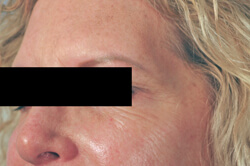
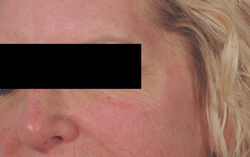 As we’ve discussed in many previous articles, the aging face begins to lose volume beginning in the upper third of the face. As muscles and facial tissue descend as we age, the upper part of the face begins to appear more hollow and angular. This hollowness is often seen in the temple areas and the condition is often referred to as temporal hollows. The loss of volume in the temple area then affects the frame of the face – the eyes. By using dermal fillers such as Juvederm or Restylane, we are able to restore volume to the temple area. Filling the temporal hollows allows for a more balanced facial appearance and brings interest back to the frame of the face, the eyes.
As we’ve discussed in many previous articles, the aging face begins to lose volume beginning in the upper third of the face. As muscles and facial tissue descend as we age, the upper part of the face begins to appear more hollow and angular. This hollowness is often seen in the temple areas and the condition is often referred to as temporal hollows. The loss of volume in the temple area then affects the frame of the face – the eyes. By using dermal fillers such as Juvederm or Restylane, we are able to restore volume to the temple area. Filling the temporal hollows allows for a more balanced facial appearance and brings interest back to the frame of the face, the eyes.
You finally did it! You went and got Restylane or Juvederm injections for tiredness under your eyes that has been driving you crazy. But after a few days, you notice something that doesn’t look quite right. A bluish or greyish discoloration is visible at the point of injection. Are you seeing things? Is this normal, and if it isn’t, how can you make it go away?
Getting dermal filler injections is a big decision. It takes time and research to understand what the procedure can and can’t do for you. You must find an injector who shares your vision that also has the skills and knowledge to make it a reality. Unfortunately, this can be the hardest part. Not every injector has the same skills. And while some have the knowledge of the proper placement and techniques that are needed to perform filler injections, their technical skill may not always be up to that same level.
If you’ve noticed a bluish or greyish hue where you’ve had filler, you may be visualizing a phenomenon known as the Tyndall effect. Without getting too heavy into the physics of light, what’s happening is that light is “reflecting” off your hyaluronic acid-based filler such as Juvederm or Restylane because it’s placed too close to the surface of your skin. Although your injector may have used the right product for your procedure and got the location of your injections right, he or she just didn’t put the filler at the right depth. You can see an example of what the Tyndall effect looks like in the photo here on this page.
The Tyndall effect is just one of the reasons that who you see for your injections is just as important as what you have injected. Your injector needs to understand the proper depth of placement for your dermal filler product to avoid the Tyndall effect.
Once it’s there, the only way to get rid of the Tyndall effect is to get rid of the filler itself. The best way to reverse the filler is to dissolve the filler product with Hyaluronidase (Vitrase). Hyaluronidase is an enzyme that breaks down common fillers like Restylane and Juvederm immediately. The painful part is that you then must start over again at square one with your filler.
Over the last several decades, hydroquinone, (HQ) has become the gold standard treatment for many skin conditions that require lightening. As the use of hydroquinone has grown, there has been much debate as to whether it’s safe and effective.
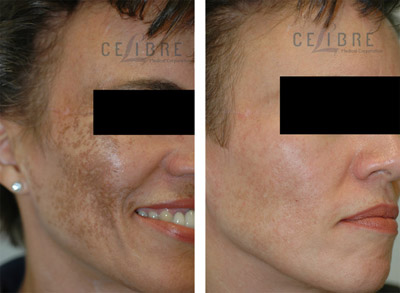 One study commonly cited as evidence for the link between hydroquinone and cancer was based upon oral ingestion of hydroquinone in lab rats and mice. Although there is value in extrapolating information from research such as this, it was recognized that the studies were lacking and are now considered outdated.
One study commonly cited as evidence for the link between hydroquinone and cancer was based upon oral ingestion of hydroquinone in lab rats and mice. Although there is value in extrapolating information from research such as this, it was recognized that the studies were lacking and are now considered outdated.
Further, there are also reports of hydroquinone use and darkening of the skin – a condition referred to as ochronosis. Although possibly underreported, ochronosis cases are very rare and associated with sun exposure, and prolonged use at high concentrations. The FDA has called for more current and inclusive studies that focus on the dermal application (on the skin vs oral) of hydroquinone to determine its effect on humans. The FDA’s position is that hydroquinone is generally safe and effective.
Currently, HQ is available without a prescription in numerous over-the-counter products at a 2% concentration. Typically, 4% is what most physicians prescribe and is also found in Obagi and other name-brand products. Anything above 2% is considered a prescriptive product and requires a prior exam by the physician, Nurse Practitioner, or Physician Assistant. This fact is important because consumers routinely purchase these products online or even at Medical Spas without going through the required prescription exam. Those practices dispensing or selling anything above 2% HQ without the required medical exam are breaking the law.
The potential adverse side effects of HQ are directly related to improper use of the product. Rather than the percentage of HQ, the more concerning factor is prolonged and uninterrupted usage of the product. For example, consumers often purchase numerous HQ products for use simultaneously. Without proper supervision and instruction, consumers expose themselves to risk by using low percentages of HQ for an extended period of time. Continuous use is where the risk lies.
At Celibre, our position is clear: hydroquinone is safe and effective when used appropriately.
Appropriate use of Hydroquinone:
Because hyperpigmentation (ex: brown discoloration) can be distressing for our patients, the topical HQ program is an excellent option.
At Celibre Medical, when it comes to using filler in the lips and mouth, we believe that less is definitely more. Technique and knowledge of optimal lip structure and anatomy trumps “plumping and filling” the lips. This is one area of the face that takes finesse and skill to inject well. When done right, the results are amazing!
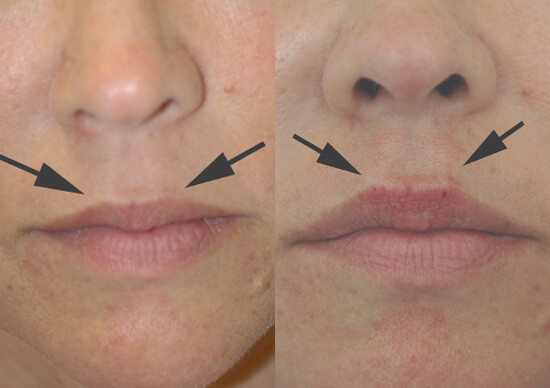
First, we want to ensure that any lip filler treatment leaves you with a symmetrical and natural-appearing mouth and lips. To accomplish this, we pay special attention to the philtral columns, the raised, vertical ridges that connect the bottom of the nose to the lips. They are different for everyone—some people have more pronounced philtral columns and others less so. The key is adding just the right amount of structure to this important area with small amounts of filler to get the most natural, youthful appearance.
As we age, the area between the nose and upper lip elongates and flattens. This accentuates a natural flattening of the upper lip that happens over time (double whammy). By using a small touch of dermal filler such as Restylane or Juvederm, we carefully recreate youthful philtral columns that accentuate the border of the upper lip. Building these columns accentuates the natural “V” of the upper lip known as the cupid’s bow. This gives your lips more shape and helps to lift and evert the upper lip (turn outward and upward).
Note that these techniques don’t involve filler in the actual lip itself, but still change the shape and appearance of it. When an injector doesn’t understand these principles and techniques and just “fills” the lips, the duck-bill or trout-pout results.
If you’re considering lip or mouth injections with dermal filler, we encourage you to discuss what techniques your injector will use. Understand how dermal filler injections can accentuate or enhance your natural beauty—not just give you big lips! Remember it’s quality, not quantity that makes all the difference between being “treated” with dermal filler injections for the lips and mouth and being “filled”.
Aging is inevitable and happens to everyone. But, some manage to age more gracefully than others. Before you assume that it’s all genetic, we’re here to tell you that “looking good” for your age often involves a secret weapon: a good aesthetic practitioner.
If you asked around, you’d be surprised at just how many people are using Botox and dermal filler treatments to look younger and feel better about the way they look. A good cosmetic practitioner has a “playbook” of minimally invasive techniques that yield big results with little to no downtime. Dermal filler injections are one of them.
An example of an area that responds phenomenally to filler injection is the nasal alar area. This is the area of the inner cheek, just beside the outer edge of your nostril. It is the very top end of your nasolabial fold or “laugh line”. As we age, this fold or crease becomes more noticeable due to structural changes and volume changes in the cheek itself. Combined with years and years of smiling and laughing (which is good!), this crease indents even further—which is bad! It can lead to a “heavy” look or like your cheek is folding in on itself.
Just a drop or two of a dermal filler product in the area next to the nose can make a big difference. Even if you aren’t bothered by too much “heaviness” in the nasolabial fold, treating this area with dermal filler can help improve your overall look by changing the topography. Without filler, it’s convex (like a bowl) which means that you’ll see a shadow in that area. Once filled, it becomes smooth which takes away the shadow effect and creates the visual effect of smoothness and fullness.
At Celibre, we like to use either Restylane or Juvederm for this area. It’s a small injection that can yield big-time results. And it’s just one of many little “tricks of the trade” that Celibre’s skilled injectors use to help you look your very best.
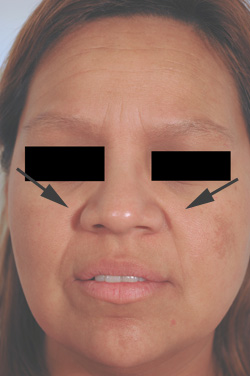

Restylane before and after pictures
We all know and love the famous actress pictured below. Although many stars deny using any type of cosmetic injection treatments to keep them looking young and beautiful. At the end of the day, it is their job to look good. It’s a good bet that almost all of them do! So, back to our friend below. Yes, she is beautiful, but when you look at this picture. You probably think something is a bit off…and you’re right! Let us tell you more about what’s gone wrong with this actress’s look.
Yep, she’s done more than just “try” Botox. She’s a regular. How do we know? Because she’s developed a tell-tale sign of long-term Botox use known as “bunny lines”. Do you see those little lines on the side of her nose? Notice that the rest of her forehead, between her eyes and even her crow’s feet area looks almost perfectly smooth when she smiles. So, what’s happening exactly?
Remember first how Botox works: It blocks the muscle receptor that is stimulated by the nerve that tells it to contract. Treated muscles stay in a constant state of relaxation. Which makes the skin look perfectly smooth instead of wrinkling with contraction (facial expression). Your brain is still telling your muscles to move and they can’t. If certain muscles can’t or won’t move to create facial expressions, others start to take over to get the job done! Bunny lines result from over-activity of the nasalis muscle on both sides of the nose. They usually only appear with a smile, so you won’t see them at rest. They happen when too much Botox has been used or when other facial muscles normally used in facial expression are constantly relaxed.
It’s no secret that we all lose facial volume as we age. One of the places where these changes can make us look dramatically older is around the mouth. There are many areas that can be injected with dermal fillers here. They include the “white” lip (area between the lip and nose), the vermillion border (the edge of the lip itself) and the lips (or “red” lip). Think of each of these as specific, different pieces of a puzzle that all need to be balanced with each other for it to look complete or right. If one area is out of proportion, the whole thing looks off. That is what’s happened here.
At rest, her lips may look great, but when she smiles, you can see that only the body of the red lip has been treated with filler. Her vermillion border is totally flat. Smiling causes the lip to “stretch” and essentially makes the upper lip look like it’s swollen and “rolled” upward over the teeth. This is not a very natural look.
This picture demonstrates the fact that cosmetic injections can be tricky. There is no one, cookie-cutter approach to any of them, Botox or filler. Your injector needs a trained, skilled and artistic eye that not only sees your natural shape and areas that need improvement, but one that can also judge and mitigate unintended consequences of treatment like the ones discussed here. Your evaluation should include an appraisal of your appearance both at rest and with expression and movement. This is the best way to judge appropriate treatments for you and tweak things that may not look quite right. This takes time, attention to detail and a personalized approach to cosmetic injections. Here at Celibre Medical, we pride ourselves on these things and believe our approach is what gives us an edge over the competition.
If you’re considering dermal filler injections for mouth or lip augmentation, there are several important things you should know before your procedure. First and foremost, you can’t (or shouldn’t) take a photograph of your injector and say, “I want lips like these!” Unlike haircuts where a certain one may look good on many different people, your facial features are distinctly yours! It’s impossible and just not aesthetically pleasing to simply recreate someone else’s lips, nose, or otherwise on your face.
The goal of mouth and lip augmentation is to make you look like a better version of yourself. Whether that’s restoring lost volume in your lips or around your mouth, correcting/softening lines around your mouth, or restoring features that have changed or been lost over time in this area, the techniques used should help you look more youthful with soft and rounded features—not like a pouty, fish-lipped, obviously over-filled Hollywood celebrity!
At Celibre Medical, we use a combination of both dermal hyaluronic acid (HA) fillers like Restylane and Juvederm with Botox / Dysport to fill and shape the lips and mouth.
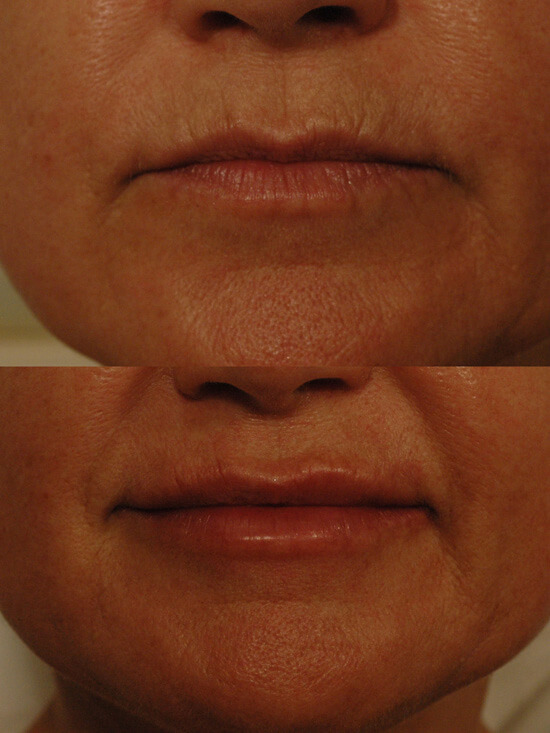
We use HA fillers to add volume and definition to the lips. We can enhance and redefine the lip border with these products and reshape the mouth by carefully placing products just outside the corners, helping to turn them up and giving you just a hint of a smile. If your lips appear “deflated” with wrinkling, HA fillers can help restore soft, natural-looking volume and soften those wrinkles.
The ideal lip proportion is the bottom lip just slightly larger than the top. If your lips have always been disproportionate or if they’ve simply just thinned out over time, HA fillers can restore or establish a more aesthetically pleasing proportion to your lips.
Aging can also trigger changes in facial boney structure and soft tissue which elongates the space between the base of your nose and your upper lip. It can also make your upper lip appear as if it’s turning inward or rolling towards your teeth. HA fillers can help restore your lip volume and return the appearance of the area around your mouth to what it was in your younger days.
One of the most common complaints from patients like you is those little vertical lines that appear around the edges of the mouth. Not so affectionately known as “smoker’s lines”, they can appear on someone who’s never smoked a day in their life! We’ve seen many women mistakenly take to removing all straws and bottles from their daily lives to prevent smoker’s lines, but we’re here to tell you that’s not why they happen either!
It is actually a combination of factors that create a smoker’s lines. Number one, repeated contractions of the circular, purse-string-like muscle around the mouth is the underlying issue, but secondly, the loss of collagen and elastin in the skin just around the lips also contributes greatly.
Many injectors will simply try to place small amounts of filler in these lines, in an attempt to smooth them out. This may work for some, but for many, it just makes the lips look disproportionate and the top lip looks heavy.
Here at Celibre Medical, we address the underlying muscular issue with Botox or Dysport. Subtle relaxation of the muscle will improve the appearance of the lines. We couple this with dermal fillers to redefine the border of the upper lip. This helps to soften the appearance of these lines, without injecting them directly. Using these combined techniques over the years has also shown us that many patients get a subtle lip eversion. This means the upper lip gently rolls outward and upward. This helps the upper lip look even fuller and shortens the distance between the lip and the base of the nose, a win-win!
As you can tell, there is a lot of artistry, skill, and knowledge that goes into lip and mouth augmentation. Before you book an appointment with an injector, make sure that you look for some before and after photos that demonstrate their skill. Also, make sure you understand the benefits and limitations of this procedure, so that you’re pleased with your results. If you’d like to learn more about Celibre Medical’s philosophy on using injectables and lasers for facial rejuvenation, please visit our laser and injectables for wrinkles page.
It’s not unusual for patients, both men, to voice concern about their motivation for seeking out aesthetic treatments.
Some curious men will ask, “Do many men get these treatments?” Women, on the other hand, will say, “No one knows that I do these treatments. I’m treating myself today.” A more recent question that I’m asked by patients when receiving their injection treatments is, “do you think I’m being vain?
 I always pause before answering that sincere question. I recognize that the average patient works hard to invest in botox treatments, and I’m very aware that they are trusting me with this investment in themselves.
I always pause before answering that sincere question. I recognize that the average patient works hard to invest in botox treatments, and I’m very aware that they are trusting me with this investment in themselves.
My answer remains the same. “No, I do not. Wanting to help your frown lines or freshen up your appearance is no different than getting your hair done or working out to maintain physical health.”
If we give attention to our physical health, maintaining our hair, nails, or wardrobe, then wanting to improve an important asset, our face, fits nicely into that routine.
I recognize that in this day of endless selfies, outrageous aesthetic treatments, and a society that is overwhelmingly promoting self-centeredness, it’s no wonder that a patient would pose that question.
I have often repeated a mantra over the years of, “crazy people do not wonder if they are crazy.” We can translate that to, “narcissists do not wonder if they are narcissistic” and finally….Vain people do not wonder if they are being vain.
Botox $8.00 per unit? Dysport $3.00 per unit? Restylane for $350.00 per syringe? We all recognize that price is important. However, most will agree that cheaper doesn’t necessarily equate to better. In fact, we would even argue that cheaper, in most cases, doesn’t even equal adequate. We often hear stories of Groupon deals wherein the Botox “did not last.” In one serious case, a patient was injected with a dermal filler obtained overseas that resulted in a serious tissue infection.
No business or practice will operate in a manner to lose money. To support pricing that is significantly below the standard in our profession, many corners may be cut. Short- cuts and compromising standards in a medical professional do not bode well for patients and also call into question the ethics of the medical professional.
What consumers may not realize is that it is illegal for a medical practice to purchase, obtain, use, or distribute Botox, Dysport, or any injectable dermal filler from anyone other than the manufacturer in the United States. Because of this widespread problem, regulations and enforcement are finally equipped to catch up with those placing patients at risk and degrading the aesthetic medical profession. See the below link for a widespread operation that targeted numerous local and non-local medical professionals illegally purchasing their products.
You may be wondering right about now if it’s worth the risks vs. the potential benefit of saving money. If the only negative outcome is a short or substandard duration with your Botox, then you are still not saving money. However, please consider that illegally obtained products cannot offer a guarantee of sterility or proper handling, or that you are even receiving a safe product. If something goes wrong, the insurance carrier for the injector will not cover the adverse event. Finally, if we cannot trust our physicians and nurse to obey the law in one area, it calls into question everything as it pertains to ethics and integrity.
We recognize that we are not the cheapest, nor do we strive to be. Our goal is to offer competitive pricing with a safe, appreciable outcome, and most of all… remains a trusted name in aesthetic medicine.
We’ve had many requests for Voluma over the past few months in response to the launch of Allergan’s newest dermal filler product. The strategy of our organization has always been to let new products earn their place in our practice by proving, over a year or two in the market, that they are worth the hype.
And that’s what product launches are – hype. The manufacturers of lasers and injection products have to hype their products with huge PR campaigns to try and make a name for their brand in an already cluttered cosmetic dermatology marketplace. They get consumers really excited when appearing on shows like “The Doctors” and “Dr. Oz”. The problem is that the reality of the product is usually quite far off from the hype and Voluma is a perfect example.

In the FDA study used for the approval of Voluma in the cheeks, the AVERAGE patient used 6.5 CC’s of product in the cheeks. Now, if you know anything about injection product, you know it’s very unusual to use this much product. In fact, most patients at our practice get a maximum of 3-4 CC’s in the cheeks. To give you an idea of how much this would cost in today’s market, Voluma is selling for between $750 and $1000 per CC. So that 6.5 CC average patients from Allergan’s study would have paid between $4,875 and $6,500 for their injections. We don’t know many consumers willing to pay that for their injections.
On top of this fact, if you inject 6.5 CC’s of ANY dermal filler, you are going to get a lot of duration, just because there is so much product in the cheeks. Voluma claims a 2-year duration, but Juvederm XC also claimed 18 months when they originally came out and if you know Juvederm, you also know it doesn’t last for 18 months. We believe that it’s very realistic for Voluma to achieve 12 months of duration, but beyond that we are skeptical and will let consumers weight in over the next year as to whether the premium cost of Voluma is worth it.

